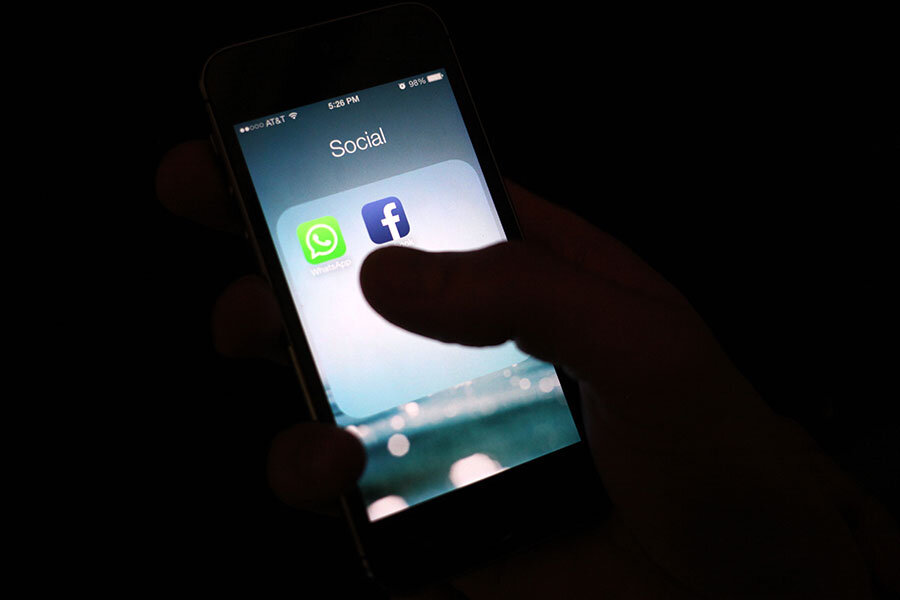Average US teen watches nearly seven hours of media daily
Loading...
A new study on the so-called “digitization” of American childhood is a “game changer” that experts say opens a new window into how – and how much – children use modern media technology.
In the words of the report by Common Sense Media, an advocacy group, the results are “astonishing.”
Children ages 13 to 18 spend six hours and 40 minutes a day, on average, with screen-based media, with almost half of that taking place through mobile devices, the study found. On any given day, 18 percent of teens are using more than 10 hours of screen media, although some of those hours might take place at the same time – texting, for instance, while watching a television show.
More deeply, the study offers an unprecedented and nuanced glimpse at a world where screen time has become seamlessly integrated into all aspects of daily life – whether sending texts or turning in a homework assignment, checking the weather or watching a feature-length film. Indeed, the study’s findings fuel a mounting debate about whether the very idea of “screen time” has become antiquated.
“Screen time can include lots of different things,” says Vicky Rideout, the study’s author. “It can be reading. It can be Skyping Grandma. It can be coding. What this study does, that no other study does, is looks exactly at how these screens are being used.”
From 'Social Networkers' to 'Readers'
Screen media is more often used for passive entertainment than for creative ventures, but this entertainment is highly fragmented, the study found. There’s not one type of media that stands out as a favorite among teens. Instead, the type of media children consume, and how much, has a lot to do with several digital personality types laid out in the study.
“Heavy Viewers,” for instance, spend more than five hours a day watching television and videos, but only three minutes playing video games. “Video Gamers,” by contrast, spend three of their nearly seven hours of screen media time playing video games. “Social Networkers,” who make up about 15 percent of teens, spend vastly more time on social media sites than any of the other groups – nearly two hours out of about eight hours of daily screen time.
But nearly 40 percent of teens qualify as either “Light Users” or “Readers,” who spend only an average of about an hour and a half a day on screen-based media. And the Readers spend that same amount of time with books, newspapers, and magazines printed on actual paper.
“The diversity is really the trend that emerges,” Ms. Rideout says.
Demographics are also a factor in children’s screen media habits. Girls, for instance, play dramatically fewer console video games than boys; 27 percent of boys say this is their favorite media activity, compared with 2 percent of girls.
Eat, sleep, tweet
Overall, the study shows a generation fully entwined with digital media.
“It is clear from this study that media are now as commonplace in youth’s lives as the air they breathe,” says Ellen Wartella, director of the Center on Media and Human Development at Northwestern University in Evanston, Ill. “This study is a game-changer.”
It taps into a growing debate among pediatricians and other child development experts about how to address screen time. Earlier this fall, the American Academy of Pediatrics announced new revisions to its longstanding media-use guidelines, which had discouraged any screen time for children under the age of 2, and suggested limiting screen time for older children to two hours a day.
“In a world where ‘screen time’ is simply becoming ‘time,’ our policies must evolve or become obsolete,” wrote members of the AAP media committee in an article published and distributed by the organization.
Rather than quick, definitive guidelines, they gave a number of recommendations for how parents can both preserve unplugged playtime and engage in children’s online life, such as monitoring content and modeling healthy digital media use.
“Parenting has not changed,” they wrote. “The same parenting rules apply to your children’s real and virtual environments. Play with them. Set limits; kids need and expect them. Teach kindness. Be involved. Know their friends and where they are going with them.”
A different digital divide
It is in these nuances where the real work is to be done, child development experts say. According to a new study to be published in the December issue of the journal Pediatrics, the income-based digital divide is quickly shrinking – at least when it comes to media device ownership and access. Researchers studying young children in an urban, low-income, minority community in Philadelphia found they had almost universal exposure to mobile devices, with most having their own by age 4.
But as the Common Sense Media study shows, there are still stark differences between income levels and demographics. African-American teens, for instance, use quite a bit more screen media than other teens – almost 8-1/2 hours a day on average.
Meanwhile, tweens (ages 8 to 12) with college-educated parents had almost two hours less screen time than tweens with high school-educated parents, while low-income teens used screen media for about an hour and a half longer than teens from high income families.
“The socioeconomic and racial/ethnic differences in children’s media use patters are inescapable and concerning,” the study concludes. “These are not necessarily negative activities, but the sheer amount of time devoted to them, and the difference among groups, is certainly noteworthy and deserves much deeper examination and discussion.”








